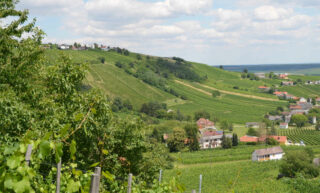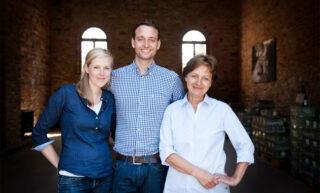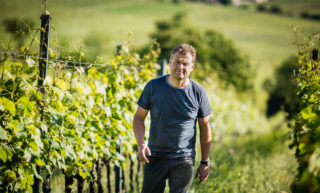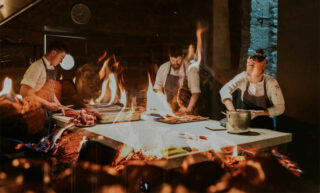The Habsburg Emperor Ferdinand already knew it in the mid-19th century – wines from the Thermenregion, the wine region south of Vienna, are fantastic. He was so fond of them that he decreed that the railroad being built through the area at the time should not damage the vineyards. Therefore, a tunnel was built between Gumpoldskirchen and Traiskirchen, two of the region's most famous winemaking villages. To this day, the region is also known as Südbahn (or Southern Rail Track).
The British royal family must have remembered this imperial appreciation, because a century later, during the 1953 wedding of the recently deceased Queen Elizabeth, the high-born guests could satisfy their taste buds with a glass of Gumpoldskirchner nectar.
Thermenregion joins Traditionsweingüter
The region, traditionally known for its spas (hence the name Thermenregion), not only has a number of interesting crus (or Riede) but is also the birthplace of two unique grape varieties, rotgipfler (white) and zierfandler (with pink skin), from which Austria’s most exported wine was made in the 1950s and 1960s.
But after that, things went quiet in the Thermenregion. Until May of this year. Then, at the last edition of VieVinum (the biennial trade fair for Austrian wine in Vienna), Michael Moosbrugger announced that nine wineries from the Thermenregion had joined the Österreichische Traditionsweingüter (ÖTW), the club of which he is the president, and which aims to develop a vineyard classification for the Alpine country.
Burgundy in Austria
As early as the Middle Ages, Cistercian monks recognized the potential of the thermal region. They must have seen something Burgundian in the calcareous soils created by deposits in the seawater that once filled the Hungarian lowland basin and brought pinot noir from France to Austria. Its exposure to the sun – the Thermenregion is located on the far eastern side of the Alps – also resembled that of the Côtes d’Or. All this led to the fact that until a few years ago, the Thermenregion liked to advertise itself as the “Burgundy of Austria,” but that is now a thing of the past.
Thermenregion ©Austrian Wine/Robert Herbst
Zierfandler is the noblest
Beautiful Pinot Noirs are still being made in the Thermenregion, but these days it is all about individuality and origin, a trademark of the ÖTW wineries. The Pinots are now an expression of their own vineyard. And those two native grape varieties, zierfandler and rotgipfler, which were so popular in the 1950s and 1960s, are coming back into the picture. The former, the nobler of the two, produces powerful wines, rich in extract, with aromas and flavors of honey, orange (zest) and peach, and are usually well balanced by sufficient acidity, which also provides the possibility of a fine dessert wine.
During a professional tasting at Freigut Thallern, a winery founded by Cistercian monks in 1141 and one of Austria’s oldest, it became clear once again that Stadlmann‘s Zierfandler Ried Mandel-Höh is among the very best. Maturation on the lees in neutral, 2000-liter oak barrels shows off the grape’s character in both the 2018 and 2020 vintages. A tiny bit of leached tannins gave the latter some pleasant grip. The 2016 vintage, which I drank earlier this year at Heunisch & Erben, one of Vienna’s best wine restaurants, showed that the wine has aging potential too. Also, Weingut Gebeshuber‘s Zierfandlers, Ried Wiege 2019 (stony mineral) and Ried Modler 2019 (smoky) were both not to be missed.
Rotgipfler is baroque
For some people, myself included, rotgipfler is a more difficult variety. During the aforementioned tasting, I heard descriptions like “gewürztraminer without gewürz” and “chardonnay on steroids,” but that does not do the variety justice. Indeed, rotgipfler has a powerful sugar buildup that often puts the wine’s alcohol content at or above 14 percent. “A Rotgipfler is voluminous, baroque and opulent,” says Hannes Reinisch, the president of the brand new regional ÖTW division, and one of the three brothers who run the Johanneshof Reinisch winery in Tattendorf. Rheinisch’s terms fit nicely with the erstwhile royal interest in the Thermenregion.
“Rotgipfler is a variety that does better in cooler years,” Hannes Reinisch continues. But even then, yield reduction and keeping the canopy small (to prevent photosynthesis) is necessary. Especially among locals, Rotgipfler has a large following. Reinisch himself, for one, likes to drink it, in particular his own. Perhaps this is because his Rotgipfler undergoes a short soaking period and ten months on the lees, partly in barrique, partly in amphora, giving it a fresh and slightly chalky-minerally character with aromas of lychees and almonds. His 2019 Rotgipfler Ried Satzing was one of the better ones on show. Still, he admits that the variety is better in a blend with zierfandler.
In fact, with only 72 hectares of zierfandler and 113 of rotgipfler (out of a total of around 2200 hectares in the entire region), these are truly niche wines, but well worth seeking out.
Reinisch brothers
Sankt Laurent is sensitive
Besides pinot noir, sankt laurent plays a leading role among the black grapes. Theories about its origin contradict each other. One of them states that the variety originally comes from Alsace, but today it is mainly found in the Czech Republic, Slovakia and Austria. Despite the fact that sankt laurent has its problems – it flowers early and is therefore susceptible to frost, it is prone to fungal disease and does not cope well with too little precipitation – the variety has experienced a resurgence in Austria. There are currently around 150 hectares planted to sankt laurent in the Thermenregion.
‘Best of’ sankt laurent
The profile of sankt laurent is sometimes compared to that of pinot noir: dark cherries, good structure (both in terms of acidity and mostly fine tannins), and ages well in oak barrels. Of the eight Sankt Laurents I tasted, Landauer-Gisperg‘s “best of” 2020 stood out. As Stefan Landauer-Gisperg, the youngest generation of the Landauer-Gisperg organic winery, says, “I flirt with floral notes and brett.” The former is caused by the carbonic maceration he applies to much of the grapes. About the latter, Landauer says, “Sankt laurent is susceptible to the dreaded yeast species brettanomyces. This can in no time flatten or even eliminate the fruitiness of a wine that was still perfect when bottled. To avoid this, I could add a generous amount of sulfite, but that is something I don’t want to do. So, I filter my Sankt Laurent. If it turns out well, brettanomyces can enrich the aroma and flavor profile with some slightly animalistic aromas and flavors.” Although the name “best of” (Landauer-Gisperg’s top line) might suggest otherwise, this is indeed a vineyard wine from Ried Braunfeld.
Those who do not appreciate a trace of brett can try, for example, Johanneshof Reinisch’s Sankt Laurent Ried Holzspur. The 2016 vintage was typical of the variety and had a fine chalky foundation. The 2008 Sankt Laurent Reserve from Weingut Schneider proved how well and long Sankt Laurent can age. Although Schneider would use fewer new oak barrels these days – it was still around 70 percent in 2008 – the long maturation produced wonderful umami-like flavors of dried plums, topped with a little tobacco and even some bacon.
Majestic wines from Erste Lagen
The Thermenregion is clearly back on track. As of 1 June this year, the region gained official DAC status allowing the vintners to label their wines with their origin. Like elsewhere in Austria, there are three levels: Gebietsweine or regional wines, Ortsweine or village wines and, topping the pyramid, Riedenweine or single vineyard wines. Other than Rotgipfler, Zierfandler, Sankt Laurent and Pinot Noir, Chardonnay and Pinot Blanc are permitted for the single vineyard wines. On top of that Pinot Gris and Zweigelt are also allowed for the village wines, and Neuburger and Blauer Portugieser for regional wines.
Meanwhile, the nine new ÖTW wineries are determining which of their vineyards may be designated Erste Lage (or premier cru). After that, sommeliers, journalists and other wine experts will spend years tasting and rating the wines. In the process, some vineyards may lose their status as Erste Lage; others may gain it. Eventually, the very best will be designated with the epithet Grosse Lage (or grand cru). By then, the United Kingdom will probably have a new king and the British will be drinking their own dry wines. That said, the Thermenregion still produces majestic wines.
Versions of this article have been published in Apéritif (in Norwegian, issue 4 2023) and on Perswijn‘s website (in Dutch, 12 October 2022)







Comments